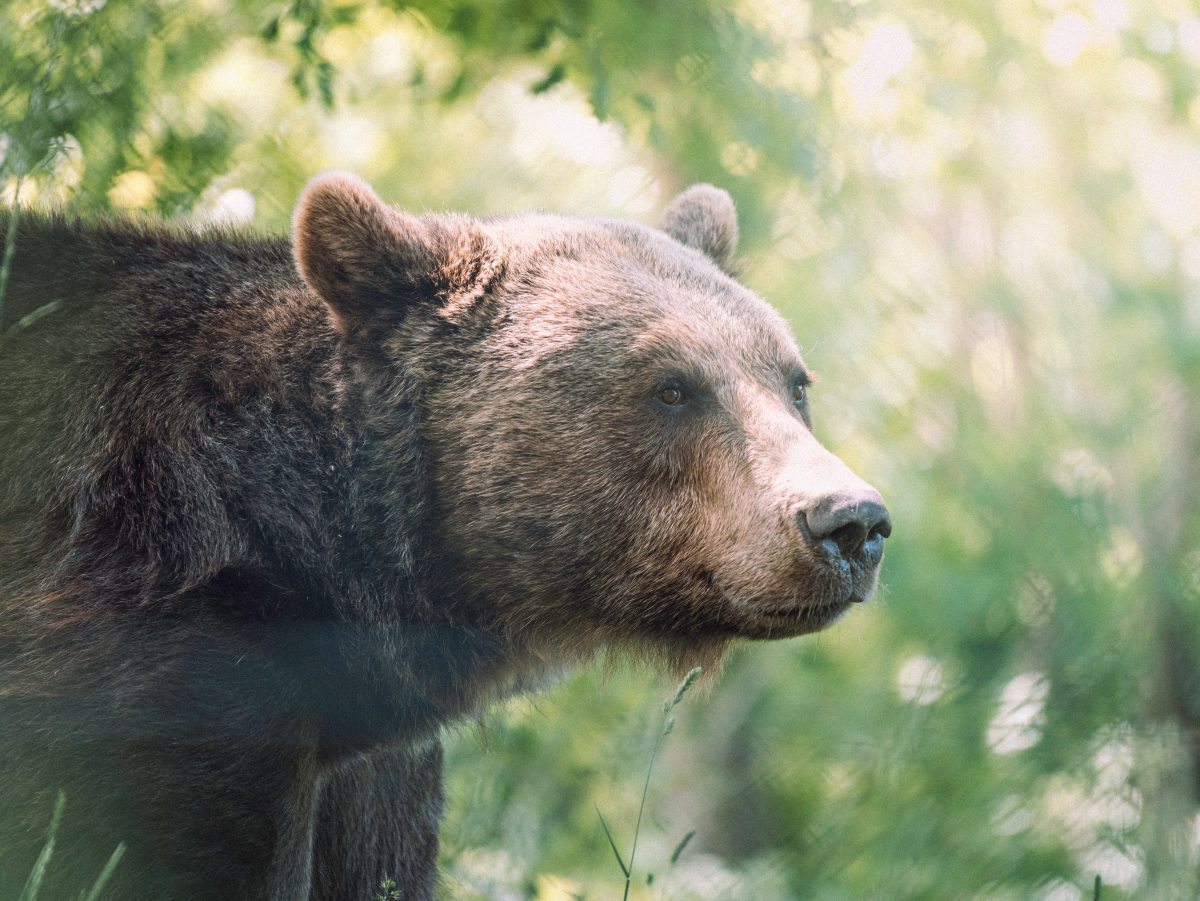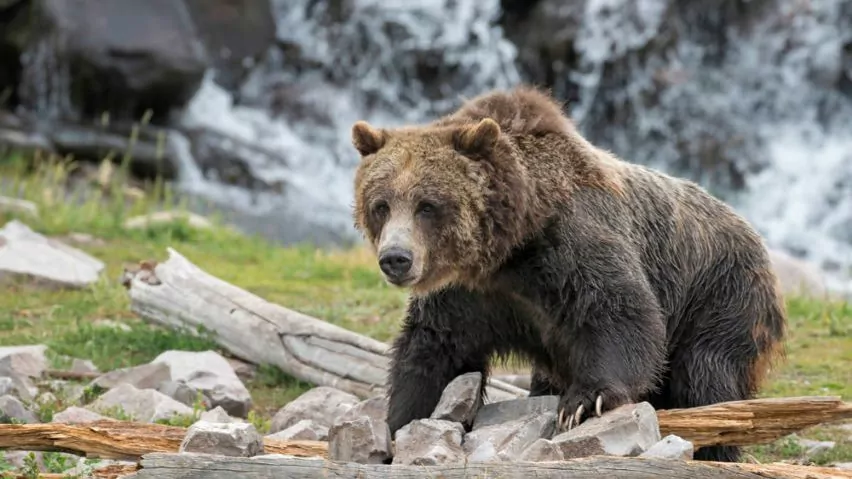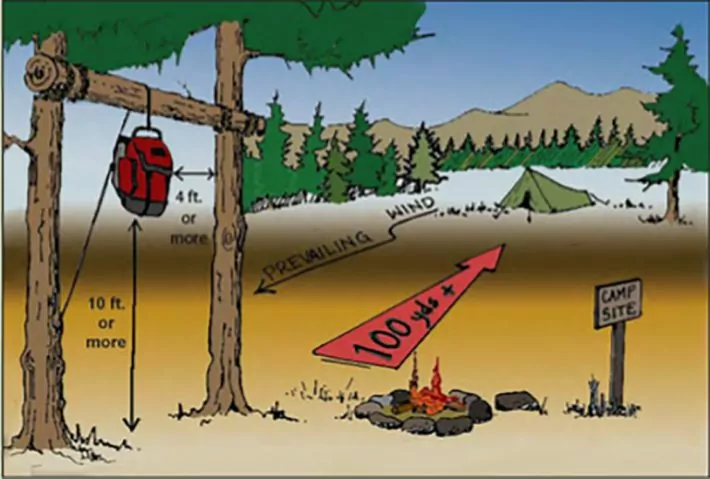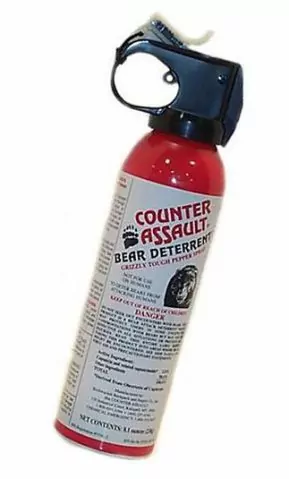
Going to Yellowstone, the Tetons, or the Wind River Range? Maybe on a Wildland Trekking hiking trip? The Greater Yellowstone Region is a pristine wilderness paradise — one of nature’s finest works in the lower 48. The region’s nearly 20 million acres envelops everything that compels a person to explore the outdoors. Rolling ridgelines, wildflower-filled meadows, dense forests, unpredictable weather.
And wildlife. Lots and lots of wildlife.
When you’re hiking in bear country, you need to stay bear aware. Black bears are common in much of the U.S., while grizzlies live in the Greater Yellowstone Region, the Canadian Rockies, and Alaska. Hiking in grizzly country requires extra bear safety measures and precautions — especially at camp. Before you set out on a backpacking trip into bear territory, we’ve outlined everything you need to know to safely hike and camp with bears.
BLACK BEARS VS GRIZZLY BEARS: WHAT IS THE DIFFERENCE?
 Thousands of people backpack in Yellowstone every year. Most never see a bear. However, that doesn’t mean they aren’t there. Maybe they saw (or most likely smelled) you first.
Thousands of people backpack in Yellowstone every year. Most never see a bear. However, that doesn’t mean they aren’t there. Maybe they saw (or most likely smelled) you first.
This region is home to two types of bears: black bears and grizzly bears (sometimes called brown bears). Now, it gets a little more complicated. Black bears aren’t always black — sometimes they’re brown, cinnamon, or blond. Grizzly bear colors can even differ. But each species has a few key differences so you can tell them apart. Don’t pay attention to size or color when determining the bear type. Instead, use these few characteristics when you see a bear:
Grizzly bears have a large should hump (pictured to the left), a dished snout, and small rounded ears. Black bears, on the other hand, have a straighter face profile, no shoulder hump, and larger ears. Now, we don’t expect you to get close enough to tell the difference, so if you’re traveling in Grizzly country, assume the bear is a grizzly until you know otherwise.
While black bears in Yellowstone create their fair share of issues — mostly food theft but also rare aggressive acts toward humans — it’s the grizzly bear that commands our rapt attention when traveling in the wild depths of Yellowstone.
Few life experiences are as memorable as seeing a grizzly in its native habitat. Zoos offer no comparison. On a backpacking trip in the Greater Yellowstone region, grizzly bear sightings are a very real possibility! Brown bears are the king beasts of most of North America (polar bears notwithstanding). And, like all noble creatures, they deserve our respect. On every guided Yellowstone backpacking trip, our goal is to see these majestic creatures — but only under the absolute safest of circumstances, from a safe distance and without disturbance. We do not ever try to get their attention. We never “go look” for bears; we let the turns of the trail reveal the park’s inhabitants and respond as long-established protocol dictates.
CAMPING WITH BEARS
 In order to fully appreciate what a wild place like Yellowstone offers us, we need to abide by some simple but critical backcountry rules when it comes to camping with bears.
In order to fully appreciate what a wild place like Yellowstone offers us, we need to abide by some simple but critical backcountry rules when it comes to camping with bears.
Paws down, the most important rules to follow when backpacking in grizzly country involve food handling.
Grizzlies have incredible senses of smell. So, when camping bear country, we store all of our food downwind and ample distance from our tents, at least 100 yards. For food storage, you have two options:
- Hard-sided bear canisters or park-provided storage boxes
- Bear hangs
The type of bear-safe food storage you use will probably depend on where you’re camping. If you’re in Yellowstone, all backcountry sites require you to hang your food. If you’re in Yosemite among the black bears, most backpacking trips require you to carry along bear canisters. Some backcountry camps will have designated food storage boxes. If you’re relying on these to keep you and your food safe, make sure they are at every single site where you plan to camp. For example, on our Classic Summits of Yosemite trip, the camp for nights 2 and 3 have storage boxes, but we need to use bear canisters for food storage on the first night. So, we carry bear canisters the entire trip!
Wherever you’re hiking, make sure you’re aware of the protocol in place for food storage safety. Of course, if you join in on a guided backpacking trip, we’ll take care of all the logistics for you. If you’re hesitant about backpacking in grizzly country, guided hikes are a great way to learn the ropes. You’ll develop the skills and confidence that you need to hike unguided in grizzly country.
BEAR CANISTERS OR BEAR BOXES
If you’re traveling into black bear territory, chances are you’ll need to carry a bear canister. These nifty capsules protect your food with a lock system that is sometimes difficult for even humans to open. National Parks like Olympic, Yosemite, the Rocky Mountains, and North Cascades require them in all backcountry sites or in alpine areas where bear hangs are impossible. Many ranger stations will rent out bear canisters so you don’t have to buy one. Although they’re bulky and inconvenient to fit in your backpack, you’ll rest assured knowing your food isn’t luring bears into camp. If you’re using a bear canister in grizzly country, make sure to choose one that has been approved by the IGBC (Interagency Grizzly Bear Committee).
Some parks have bear boxes at campsites, making your backpacking trip a breeze! Just be sure to properly close them each time you secure your food in there. While many parks, like those in the Sierras, provide locking steel boxes at some backcountry sites, Yellowstone does not.
BEAR HANGS
If you’re using bear hangs, you’ll need to pack in a rope (at least 35 feet), carabiner, and a few stuff sacks for your food and scented items. If you’re going on a long trip or are bringing a lot of food, you may need to bring multiple bear hang systems.
Bear hangs come in two varieties, 1) pre-established bear hangs and 2) improvised bear hangs.
In Yellowstone, the National Park Service has built bear hangs at all backcountry campsites. In other parks or wilderness areas, you may need to seek out the perfect tree on which to hang your food.
Pre-established bear hang systems are relatively easy to use — two tall trees support a sturdy cross-beam where you’ll hang your food. Fill a small stuff sack with a rock or heavy, unbreakable item, and attach it to the carabiner. Then, attach the carabiner to the end of your rope. Toss the rope up and over the beam — the stuff sack should fall so you have both ends of your rope on the ground. Then, replace the rock with your bags of food, and pull the opposite end of the rope until your food is suspended at least 10 feet up. If you have really heavy food bags, you may need a pulley system to haul your food — or to separate your food into a few bear hangs. Then, tie the rope off to a nearby rock or tree so your food stays put. Unless you are actively using your food bags, they should stay hung for your entire time at camp.
If you have to find your own tree to use as a bear hang, you’re in for a fun adventure. The process of hanging the food remains the same, but it gets a bit tricky as you deal with branches and leaves. You’ll need to find a tree with a hefty enough branch that you can hang your food more than four feet from the trunk of the tree. If your food is too close to the tree, a bear can climb it to access your goodies.
WHAT GOES INTO YOUR CANISTER OR BEAR HANG?
You’ll store all your food and trash inside your bag or canister. In addition to food and trash, you’ll add all of your scented toiletries, like our soaps, lotions, toothpaste, deodorants, and even our lip balms to the food cache. Every night before bed, you should double-check your packs and pants pockets for snacks and wrappers, even the errant cashew or breath mint.
When you’re in grizzly country (or bear habitat in general), never ever keep food in your tent. Your tent should be your sanctuary; you shouldn’t even eat in there. Also, never leave food in an unattended pack. Do you want to go scope out a side trail to the nearby summit? Bring your pack. If you plan on stashing it, make sure to hang your food or store your bear canister away from the trail. Not only will these practices keep you safe in bear country, but they’ll also prevent smaller critters, like chipmunks and marmots, from chewing holes in your pack while trying to find the goodies.
TIPS FOR CAMPING IN BEAR COUNTRY
If you follow some simple protocol for keeping your camp clean and staying bear aware while you hike, you can have a fun, successful adventure. Here are the top tips we’ve learned from years in the field:
- Keep a clean, organized camp.
- When you’re cooking, clean up any food mess that falls to the ground. Pack out all food waste (even small leftovers and crumbs) in a trash bag and then put this in your bear hang or canister.
- Dutifully clean all cookware — don’t leave a pile of dirty dishes at camp at night.
- Disperse dish water at least 100 yards from where you sleep.
- Don’t throw food scraps in the fire.
- Always let someone know when you leave camp for any reason.
- Have your bear spray on you at all times, even when you leave your tent at night to use the bathroom.
- Watch and respond appropriately to all signs of bear activity, like feces (scat) and tree scrapings.
- Never spend any time near an animal carcass — even roadkill in busy places.
While this sounds like a lot to worry about, you should get acquainted with these best practices. They apply to all backpacking scenarios, even when your biggest wildlife encounter is an attention-starved ground squirrel.
BEAR SAFETY

On Wildland trips, we always carry bear spray as a safety precaution in case we ever encounter a bear not real pleased with us. All Wildland Guides are trained to use bear spray and all guests are given a lesson. If you’re hiking on your own, you should carry bear spray at all times in grizzly country. It can also be helpful in black bear territory, but it is not as crucial.
Basically, bear spray is like personal-defense pepper spray, but strong enough to take on even the biggest bear. Here’s a breakdown by the National Park Service on bear spray’s beneficial purpose for both people and bears. You should never attempt to use a lethal weapon on a bear — guns are incredibly ineffective at preventing aggressive bear behaviors — in fact, they more often just aggravate the bear.
TIPS FOR BEAR SAFETY WHILE HIKING
On our backpacking trips in the Greater Yellowstone region, we discuss numerous bear safety precautions. If a bear does happen to show aggression, you’ll know how to react. While aggressive bear behavior is very rare, it is crucial for everyone in a backpacking party (or hiking group) to understand how to travel safely in the woods with bears. Whether you’re traveling solo or just want to boost your knowledge before your guided backpacking trip, here are some helpful tips for hiking in bear country:
- Hike in a group to reduce the risk of bear attacks.
- Make some noise as you hike, especially if you’re coming around a blind corner. You don’t want to startle a bear. (But don’t overdo it. You are in the wilderness, after all.)
- Avoid hiking at dusk and dawn when bears are most active.
- Have quick access to your bear spray while hiking — the waistband is a common location. Don’t put it in your pack.
- Learn how to use bear spray properly before you carry it.
- If you see a bear, back away slowly and give it plenty of space. If you see a mama and cubs, give them even more room.
- If you see a grizzly, don’t yell or make noise. Stay calm. Don’t make sudden movements or climb trees.
- On the incredibly rare chance a bear does charge you, stand your ground and have your bear spray ready. Most charges are bluff charges.
- Only deploy your bear spray when a bear is actively charging you and comes within 30 feet or less.
- If a defensive bear (signs include: head low, ears back, huffing, snorting, mama with cubs) makes contact with you, drop to the ground and play dead. Put your backpack over your head and neck. Stay quiet so you do not seem like a threat. Remain still for minutes after the bear has left. However, do not do this if the bear is not actively attacking you.
- If you’re attacked by a curious bear (head up, ears erect, standing on two feet), fight back.
Knowledge is power when you’re traveling in grizzly country — in the rare case of a charge or attack, you’ll have the skill set to react appropriately to minimize the risk involved with a bear encounter. We hope you feel more competent and confident. But hopefully, this is knowledge we never have to deploy.
No comments:
Post a Comment